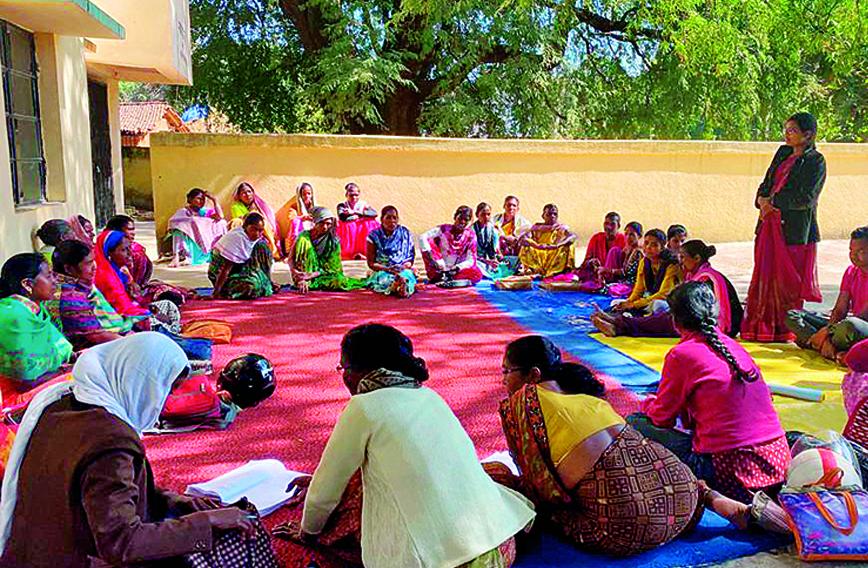
A women’s collective discusses poverty indicators
Villagers identify the ultra-poor
Iqra Khan, Ranchi
HOW do you identify the ultra-poor in a village? The most efficient way is to ask the community to come up with indicators according to their values, found PRADAN, which has been working in Adivasi hamlets in Jharkhand for many years.
Finding out who the ultra-poor are can be challenging because they are generally bracketed with a broad category of people living in extreme poverty, say economists Abhijit Banerjee and Esther Duflo.
PRADAN decided to design an identification process and then intervene to help the ultra-poor. After working out the framework of their research, they conducted a study in 10 villages of four panchayats in the Torpa block of Khunti district in Jharkhand.
Around 42.16 percent of Jharkhand’s population is multi-dimensionally poor, making it the second poorest state in India. The latest edition of the Multidimensional Poverty Index, 2021, released by NITI Aayog, reaffirms the paradox of Jharkhandis being deprived of basic amenities despite the state owning abundant natural resources.
Many Adivasi hamlets in Jharkhand bear the brunt of extreme poverty. Torpa block is one such pocket. Two decades of PRADAN’s engagement in Adivasi regions have contributed to its improvement, yet a significant part of the population, around 10 to 15 percent, remains deprived of the benefits of development programmes.
A ‘wealth-ranking tool’ was adopted to identify such families through community-led institutions such as women’s collectives and self-governance forums like the tola sabha which is similar to the gram sabha. All residents come together to decide issues concerning the hamlet. Village-level forums were sensitized on what constitutes extreme poverty and a shared understanding emerged. Poverty indicators were decided by tapping into humane and tribal values.
Once such ultra-poor families and individuals were identified, gram sabhas were facilitated to register the ultra-poor and prioritize them in government programmes and schemes.
COMMUNITY MARKERS
Based on the indicators listed by the community, 59 families/individuals were identified as ultra-poor from 10 villages with the help of local institutions. The indicators analyzed were: families or individuals who could not manage more than four or five months of rations annually, landless families, those ostracized by the community, women-led families with dependants, single women, distressed migrant families, the mentally or physically disabled, and orphans.
The ultra-poor are deprived of basic social welfare schemes. They remain bereft of Aadhaar because of the information divide, inadequate enrolment facilities, updating and retrieval issues and technical biometric glitches.
For sustenance, most ultra-poor families engage in multiple livelihood options due to lack of assets, human and financial resources, poor physical health, caste discrimination and occupational structure, social norms, low land productivity, and lack of irrigation resources.
Because of a myriad of vulnerabilities, it becomes difficult to apply one straitjacket solution to help the ultra-poor. Here are profiles of some of the ultra-poor and vulnerable families in Khunti district.
S. Topno, 43, a single woman and resident of Marcha, has psychiatric disabilities. She lives in a kutcha house with a roof that needs repair, but no one offers to help.
P. Hemrom, 48, a resident of Manmani, lives with her husband and four children. The couple is mentally unsound and doesn’t receive a pension because they don’t have the required documents.
M. Dhanwar, 48, a mentally unsound resident of Jagu village, lives with her nine-year-old daughter who was born out of forced physical relationships by men who used to exploit her. She has neither an Aadhaar card nor a disability certificate.
The deplorable conditions of everyday survival of the ultra-poor are due to the intersection of different identities. They are at the receiving end of structural violence. Therefore, each family requires abundant attention from various stakeholders as well as customized pathways to assist them.
There are different faces of vulnerability layered with multiple disadvantages. Prominent among these are social and economic disadvantages, geographical limitations, political scenarios and limited coping capacity coupled with insecurities.
Some indicators in isolation have contributed to understanding the condition of the ultra-poor, while in other cases, a couple of factors together account for the extreme poverty.
Social capital is another factor that plays a crucial role in the lives of the poor. Those with social capital tend to fare better than those lacking contacts or those not part of women’s collectives or the tola and gram sabha.
For instance, R. Devi, 33, a resident of Dao Toli, lives with her family of four and has access to welfare programmes like rations, livestock schemes, and credit facilities. She says that her family benefits from her being a part of the SHG and the neighbours approach them first if they have to hire labourers for work.
The ultra-poor are predominantly women. But caste dynamics, social standing, and occupation together also contribute to increasing the vulnerability of the poor.
K. Lohra, 80, a resident of Jagu village, doesn’t own a home and lives in a dilapidated room. He has neither a ration card nor a pension to sustain himself. He has a daughter who went with someone to work in the tea gardens in another state and never returned.
Sensitizing every local forum about its most vulnerable and poor section of society is critical. To help them access their rights and entitlements, one needs to sensitize the community, build the capacity of the ultra-poor, customize suitable livelihood options and create awareness of their rights.
Forms of assistance are consumption support, access to welfare schemes, counselling of people with psychiatric disabilities, sensitization workshops for community members, admission of children in government boarding schools, waiver of school fees, capacity building of members with alternative livelihood options, and access to interest-free loans.
Iqra Khan is a development practitioner working with PRADAN. She holds a master’s in development studies from the Azim Premji University
Comments
Currently there are no Comments. Be first to write a comment!



